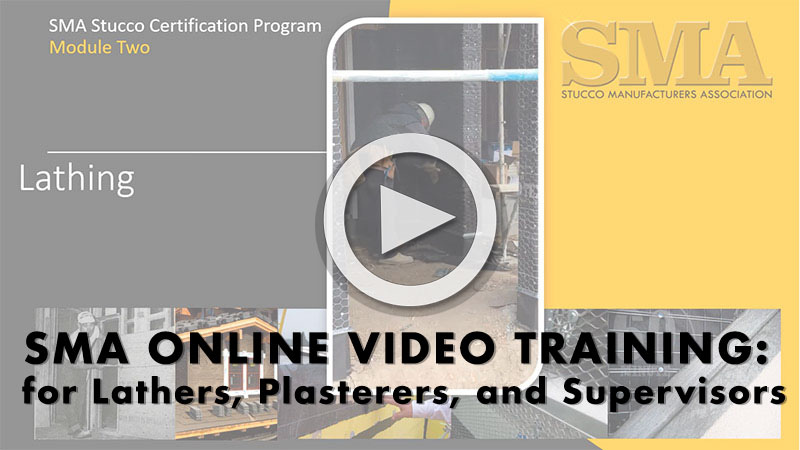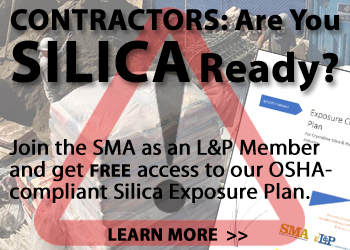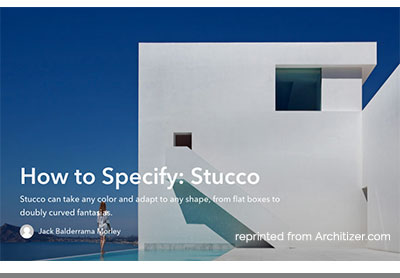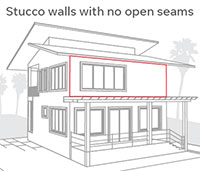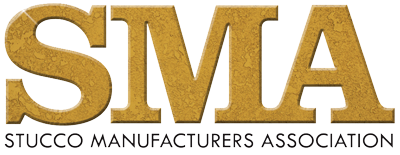MESSAGE FROM THE SMA EXECUTIVE DIRECTOR: Politics, Construction and Stucco

Mark Fowler, SMA Executive Director
With Spring 2017 almost here and the year well under way, the future has many concerned. It is pretty clear our new President is not going to be business as usual and, depending who you ask, will solicit a different response. While I have always been of the opinion that business cycles change very little with regard to who is President, this time may be different. Since we are in the world of construction and stucco, what could change for us?
One example is the new OSHA silica exposure law that goes into effect June 2017 for contractors and in 2018 for manufacturers. The law was passed with the previous administration, and the new rule has been proclaimed that if you want a new regulation, you must drop two. Will the new Silica law be one that is eventually dropped? While it is very possible, it may be worth noting that OSHA fines are increasing, so is it worth the risk to ignore the new law in the hopes it will be dropped soon? Probably not. A first-time OSHA citation may not be too bad, but they become more and more hurtful until it is a sledge hammer over your head.
The new rule has cut Permissible Exposure Limits (PEL) in about half. OSHA has developed a few paths to compliance. One: verify that all products used or touched contain zero crystalline silica. This is possible, but may not be practical for a variety of reasons. The next option: monitor the air and verify within a reasonable doubt that exposure will be below the PEL for your workers. This is possible, but materials, tools and tasks must not vary. The final option: follow what is called TABLE 1. This table lists tasks and certain engineering controls, such as water delivery and vacuums to keep dust down. In some cases, respirators may be required. If your company adheres to the TABLE 1 directives, you are in compliance and no air testing is required. Most seem to be opting this direction, as OSHA inspectors will generally leave you alone seeing dust levels kept under control. Regardless of which plan you adopt, you must have an Exposure Control Plan and an assigned Competent person. You must also offer medical exams to those required to wear respirators. If you are holding out for the rule to be overturned, I hope you are right. The price could be steep if you are wrong.
The ASTM committees on lathing and plastering have been very active. Changes are coming with regard to design and installation of lath and cement stucco. The way contractors did stucco in the past will no longer be compliant to ASTM standards. There are even proposals for additional or brand-new standards in stucco. It is likely that cement stucco will become more complicated with fewer options.
PLEASE NOTE: SMA OFFICE CONTACT INFORMATION
Mark Fowler, Executive Director
Marlene Lampert, Office Manager
Stucco Manufacturers Association
5753 E Santa Ana Cyn Rd, Suite G-156
Anaheim, CA 92807
Office: 213 379 5890
Mark@stuccomfgassoc.com
Marlene@stuccomfgassoc.com
SAVE THE DATE — NEXT SMA MEETING ON MAY 24
The next SMA meeting will be May 24 at Yorba Linda Country Club and cover the new OSHA silica exposure ruling. Program details, speakers, flyer and online sign-up will be available soon.
Feature Articles
What is Rain Screen?
Rain screen has been historically credited to being started in Canada, though other countries contend they actually created the idea long before the Canadians. The concept is fairly simple if you understand concealed barrier moisture management systems. These systems have been common for the cement stucco industry for many decades. Rain screen came about in the 1960s and quickly died. The cost to install rain screen became prohibitive, and most designers and owners felt comfortable with concealed barrier claddings and spending the extra money for rain screen seemed pointless. Times have changed. It should be noted there have always been two methods to stucco moisture management prior to rain screen: barrier and concealed barrier.
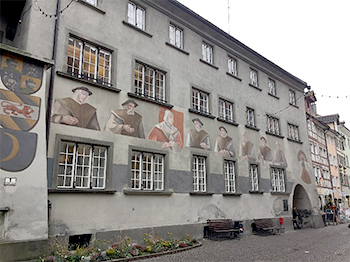 BARRIER STUCCO is the oldest stucco assembly known to man. It is still commonly used in many parts of the world. It is a two-coat cement stucco over concrete or masonry substrates. The stucco or plaster coating adds weather protection and an aesthetic appeal to plain masonry walls. This can be traced back centuries. The picture with the medieval characters is dated from 1510 and was renovated again in 1860. There is no drainage provision and the cement plaster keeps the water out of the building. It certainly does not hurt that the walls are over 24 inches thick of masonry or rock. The concept still works, as masonry is a stout building material and does not tend to move or flex. Cracks that do develop tend to be very tight hairline and are not a problem for water intrusion. The next SMA newsletter article [below] explains why. Large cracks can and do occur on occasions, and patches can be seen on these old building for repair of large or wide cracks.
BARRIER STUCCO is the oldest stucco assembly known to man. It is still commonly used in many parts of the world. It is a two-coat cement stucco over concrete or masonry substrates. The stucco or plaster coating adds weather protection and an aesthetic appeal to plain masonry walls. This can be traced back centuries. The picture with the medieval characters is dated from 1510 and was renovated again in 1860. There is no drainage provision and the cement plaster keeps the water out of the building. It certainly does not hurt that the walls are over 24 inches thick of masonry or rock. The concept still works, as masonry is a stout building material and does not tend to move or flex. Cracks that do develop tend to be very tight hairline and are not a problem for water intrusion. The next SMA newsletter article [below] explains why. Large cracks can and do occur on occasions, and patches can be seen on these old building for repair of large or wide cracks.
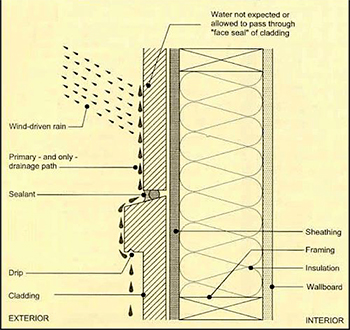 CONCEALED BARRIER STUCCO is the most commonly used in the United States. This is due to the fact Americans use more framing than other parts of the world. Framing with a thin cement shell required a shift in methodology for moisture management. First, framing tends to be more flexible and these walls move more than masonry walls. This is an advantage and even preferable during seismic events. While masonry can be used in seismic prone regions, the design requires significant amounts of extra steel reinforcing. Wood and steel framing have been popular in the U.S. for over one hundred years. There was a learning curve from putting stucco over masonry to stucco over framing. The first decades did not go well, and problems occurred. It was discovered that even small amounts of water that work behind stucco, that had no impact on masonry, had tremendous impact on bare wood. The solution was to place a layer of rag felt that was commonly used on roofs behind the stucco to protect the wood framing. Soon flashings improved, weep screed came along in 1954, and by the 1960s stucco was a recognized functional concealed barrier assembly. The rag felts were soon replaced with more vapor permeable asphaltic kraft building papers. This system was the basis for the Uniform Building Code and various standards for several decades. Concealed barrier worked, as minor or “incidental” moisture was kept from reaching the water-sensitive wood. The system was basic, simple, easily taught to workers.
CONCEALED BARRIER STUCCO is the most commonly used in the United States. This is due to the fact Americans use more framing than other parts of the world. Framing with a thin cement shell required a shift in methodology for moisture management. First, framing tends to be more flexible and these walls move more than masonry walls. This is an advantage and even preferable during seismic events. While masonry can be used in seismic prone regions, the design requires significant amounts of extra steel reinforcing. Wood and steel framing have been popular in the U.S. for over one hundred years. There was a learning curve from putting stucco over masonry to stucco over framing. The first decades did not go well, and problems occurred. It was discovered that even small amounts of water that work behind stucco, that had no impact on masonry, had tremendous impact on bare wood. The solution was to place a layer of rag felt that was commonly used on roofs behind the stucco to protect the wood framing. Soon flashings improved, weep screed came along in 1954, and by the 1960s stucco was a recognized functional concealed barrier assembly. The rag felts were soon replaced with more vapor permeable asphaltic kraft building papers. This system was the basis for the Uniform Building Code and various standards for several decades. Concealed barrier worked, as minor or “incidental” moisture was kept from reaching the water-sensitive wood. The system was basic, simple, easily taught to workers.
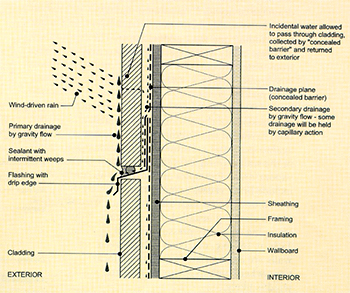 RAIN SCREEN is the concept to add an air space between the cement plaster and the building felt or paper. Furring strips can be used. This space allows for faster and more drainage of water. If the top and bottom of the assembly are kept open, the system becomes a Pressure Equalized systems to negate negative pressures and facilitate drying. The system, just as it did in 1960, adds substantial costs to installations. It also tends to be complex with more intricate detailing required. This is why Building Envelope experts are often employed to help design, pick materials and overview the installation process. The contractor must also charge more as there are more pieces to install.
RAIN SCREEN is the concept to add an air space between the cement plaster and the building felt or paper. Furring strips can be used. This space allows for faster and more drainage of water. If the top and bottom of the assembly are kept open, the system becomes a Pressure Equalized systems to negate negative pressures and facilitate drying. The system, just as it did in 1960, adds substantial costs to installations. It also tends to be complex with more intricate detailing required. This is why Building Envelope experts are often employed to help design, pick materials and overview the installation process. The contractor must also charge more as there are more pieces to install.
CODE REQUIRED is a term occasionally used to promote rain screen. Vancouver BC was the first major city to mandate rain screen in the 1990s. Most U.S. cities have no such mandate. It is advisable to contact your local building department to verify that rain screen is not a code minimum requirement. The SMA believes designers should have the option to decide which methodology is best for their building-based substrates, location and proven local practices. Rain screen may be appropriate, but not for every project. While rain screen may be best left for extreme climate zones with frequent wind-driven rains, added cost to design and build a rain screen is generally anywhere from 30% to 75% more than conventional walls. This may not include the cost of a Building Envelope consultant, which is recommended when rain screen is used as the complexity increases. Factors for rain screen design:
- The region has frequent heavy rains
- Very few drying days
- Exposed to wind-driven rain
- No over hangs
- Excessive penetrations in the cement membrane
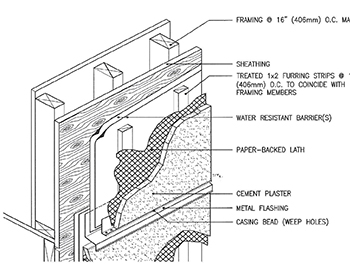 The vast majority of stucco projects do not need rain screen design for stucco to work. [The furred rain screen graphic is courtesy of the Northwest Wall and Ceiling Bureau.] Concealed barrier stucco has been verified by Oak Ridge Laboratories to drain excellently. The drying benefit of rain screen is primarily for the cladding material and has little benefit for structural framing per the BRANZ reports on rain screen testing in Australia. Cement plaster, unlike wood siding, is essentially unaffected by moisture. Always check with building department for local requirements.
The vast majority of stucco projects do not need rain screen design for stucco to work. [The furred rain screen graphic is courtesy of the Northwest Wall and Ceiling Bureau.] Concealed barrier stucco has been verified by Oak Ridge Laboratories to drain excellently. The drying benefit of rain screen is primarily for the cladding material and has little benefit for structural framing per the BRANZ reports on rain screen testing in Australia. Cement plaster, unlike wood siding, is essentially unaffected by moisture. Always check with building department for local requirements.
Stucco, Cracks and Water
The industry acknowledges that occasional hairline cracks in cement stucco are inevitable. The relatively thin brittle stucco shell, properly mixed and applied, is abuse, water, pest and crack resistant when installed correctly. This makes stucco a preferred and affordable exterior cladding for long life with low maintenance. However, under stress, this hard shell can and will develop an occasional hairline crack when the stress overcomes the strength of the plaster. The question that continues to plague the design industry and some experts is: will these cracks in cement stucco cause water passage? The short answer is yes, but the concealed barrier system anticipates incidental will get in. But how much? It should not be surprising that size of the crack has a direct relation to amount of water that will pass the stucco membrane.
The stucco industry stands by the general statement that a hairline crack in a properly mixed and applied cement plaster is not a defect nor source of water intrusion. Ample evidence is available from testing and site investigations. The German Institute of Concrete Technology at Aachen University and the technical paper ( 96-M56) published by the American Concrete Institute are further proof. The published paper on hairline cracking in concrete or cement was developed as a result of testing concrete water pipes. The pipe industry knew hairline cracks in cement pipes were not an issue for leaks. The research and paper explains in very scientific terms how and why hairline cracks tend to seal themselves through a process called “Autogenous” healing. Simply put, when free water passes through cracks in cement, calcium carbonate and other minerals are formed and these are proven to seal small to even medium fissures in cement. Constructors of concrete water towers knew this, too, as they built hundreds of these towers all across America in the 1950s and ’60s.
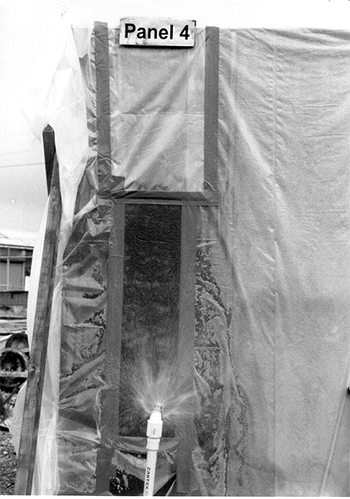 How do hairline cracks work in cement stucco? Federal Testing Labs was commissioned to test the porosity of cement stucco at ¾ inch thickness in the 1990s. The local plaster bureau verified the cement plaster was mixed per ASTM and applied with sufficient pressure to encase the lath, then properly floated to densify the basecoat and moist cured. No finish coat was added. After water testing, it was determined the un-cracked cement plaster did not allow the passage of water, even after extended periods of time. This is no surprise, as previous and other tests have provided similar results. The question was “what if the panel had a hairline crack in it?” It seemed a fair question as most cement stucco will develop a few hairline cracks. It was agreed to intentionally stress the mock-up (test Panel 4) to induce a horizontal hairline crack less than 1/16 of an inch wide. It was verified the crack went completely through the 3/4 cement membrane. The building paper was removed on the backside of the cement plaster. The crack was then traced with a felt pen for clear visual observation.
How do hairline cracks work in cement stucco? Federal Testing Labs was commissioned to test the porosity of cement stucco at ¾ inch thickness in the 1990s. The local plaster bureau verified the cement plaster was mixed per ASTM and applied with sufficient pressure to encase the lath, then properly floated to densify the basecoat and moist cured. No finish coat was added. After water testing, it was determined the un-cracked cement plaster did not allow the passage of water, even after extended periods of time. This is no surprise, as previous and other tests have provided similar results. The question was “what if the panel had a hairline crack in it?” It seemed a fair question as most cement stucco will develop a few hairline cracks. It was agreed to intentionally stress the mock-up (test Panel 4) to induce a horizontal hairline crack less than 1/16 of an inch wide. It was verified the crack went completely through the 3/4 cement membrane. The building paper was removed on the backside of the cement plaster. The crack was then traced with a felt pen for clear visual observation.
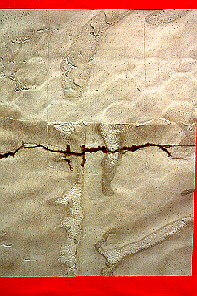 On the face side of the stucco panel, the water supply was directed to spray above at the horizontal crack. Water output exceeded ASTME 1105 requirement of 5 gallons per square foot per one hour. On the backside of the panel, water immediately started to come through as the thin dark line became thick almost instantly, see picture with thin dark line. This was concerning, as water came in fast. After just 45 seconds, the water was running, finding the lower valleys of the crack, and very visible drips were extending down as much as eight inches.
On the face side of the stucco panel, the water supply was directed to spray above at the horizontal crack. Water output exceeded ASTME 1105 requirement of 5 gallons per square foot per one hour. On the backside of the panel, water immediately started to come through as the thin dark line became thick almost instantly, see picture with thin dark line. This was concerning, as water came in fast. After just 45 seconds, the water was running, finding the lower valleys of the crack, and very visible drips were extending down as much as eight inches.
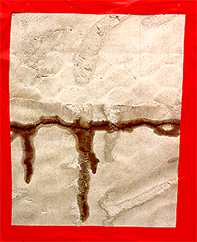 After 90 seconds of continual water application, the drips stopped growing and appeared to be even drying up. Refer to the picture with the red tape completely around the test area. Looking closely, one can see the outer edges were not as saturated. There were concerns the water supply had stopped. However, the water spray was continuous and steady.
After 90 seconds of continual water application, the drips stopped growing and appeared to be even drying up. Refer to the picture with the red tape completely around the test area. Looking closely, one can see the outer edges were not as saturated. There were concerns the water supply had stopped. However, the water spray was continuous and steady.
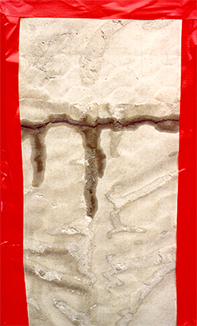 After 5 full minutes of continual water spray at the hairline crack in stucco, the drips became clearly less saturated. The hairline crack itself was wet, but water had clearly stopped coming through the crack. Refer to the picture with no red tape along the bottom of the test wall. This picture was taken at the five-minute mark into the water test and it was obvious the bulk water passage had stopped. The stucco industry has always stood by the statement that hairline cracks in cement stucco have little to no impact on water leakage through countless investigations. This testing by Federal Labs verified why water and hairline cracks in stucco are generally not problematic. Comments by observers where made as to the impact negative pressure might have had on this test. It was agreed that having a concealed barrier of black paper, house wrap, fluid applied membrane and the interior gypsum wallboard in place would negate the effects of any negative pressure. This would be representative of what happens in the real world with regard to hairline cracks on a properly mixed and applied cement plaster.
After 5 full minutes of continual water spray at the hairline crack in stucco, the drips became clearly less saturated. The hairline crack itself was wet, but water had clearly stopped coming through the crack. Refer to the picture with no red tape along the bottom of the test wall. This picture was taken at the five-minute mark into the water test and it was obvious the bulk water passage had stopped. The stucco industry has always stood by the statement that hairline cracks in cement stucco have little to no impact on water leakage through countless investigations. This testing by Federal Labs verified why water and hairline cracks in stucco are generally not problematic. Comments by observers where made as to the impact negative pressure might have had on this test. It was agreed that having a concealed barrier of black paper, house wrap, fluid applied membrane and the interior gypsum wallboard in place would negate the effects of any negative pressure. This would be representative of what happens in the real world with regard to hairline cracks on a properly mixed and applied cement plaster.
Years later, the term Autogenous healing and the science made more sense. Some experts note this test had no negative pressure. While absolutely true, negative pressure is like a vacuum that can suck the water through the crack. However, on most buildings that have a stucco cladding, the cavity is filled with insulation, covered with gypsum wallboard and then taped. This is an air barrier and would negate that negative pressure. The Energy Code confirms that a layer of gypsum board, taped and sealed, is a code-compliant air barrier.
Industry Crack Policy
The argument—over what is a hairline crack, should it be fixed and is it a water problem—may never be resolved. However, there is consensus in the industry on some issues regarding cracks in stucco. Fifteen industry associations ranging from manufacturers to contractors and covering regions from Illinois to Texas and Washington to California produced a joint Technical Bulletin in 2008. The technical paper covers cracks in stucco, types, likely causes, and the recommended width cracks when cracks should be repaired. The paper is entitled Technical Bulletin 4 and available as a free download.
Industry News
noteworthy:
- After several decades in the Southern California market, Expo Stucco has closed down operations.
- The ASTM is preparing new standard on plaster trim accessories.
- The SMA is working with other groups in Washington, D.C. to provide education and training on lath and plaster.
Buck Buchanan to Retire from Parex USA
After 21 years with Parex, Buck has decided to retire from the company. Buck joined Parex in Georgia in 1996, and prior to that he spent 15 years with Sto. During his time with Parex, he saw the company experience tremendous growth as well as survive the economic crisis that started in 2008.
He started with Parex as the Director of Technical Services, R&D, and Marketing. In 2001, Buck took on a new challenge as the Director of Sales. His job was to grow sales and develop a national distribution network.
When Parex acquired La Habra and El Rey Stucco in the early 2000s, Buck continued to lead the Parex sales team. In 2005 the company decided to merge the three businesses together, and Buck was selected to lead the transition. In 2006, he took on yet another challenge and moved from Georgia to California to serve as Vice President of Sales of the Façade Business. Tasked with developing that business division, he oversaw the sales force, marketing and national sales.
In early 2016, Buck moved back to the South as the Sr. Vice President. In this role, he oversaw international business across 27 countries. He was also involved with the Parex USA architectural sales team and assisted with mergers and acquisitions.
Buck has a long history of being involved with the EIFS trade association (EIMA) and has served as president three different times. He has also served on the boards of the SMA and the AWCI Insurance Company.
In 2015 Buck became a published author with his first book, First and Thirty, which is available on Amazon in paperback and Kindle. For more information about his book visit his website: www.booksbybuck.com
Going forward, Buck seeks other challenges—maybe other books, consulting, new ventures, or just being a Grandpa, time will tell.

